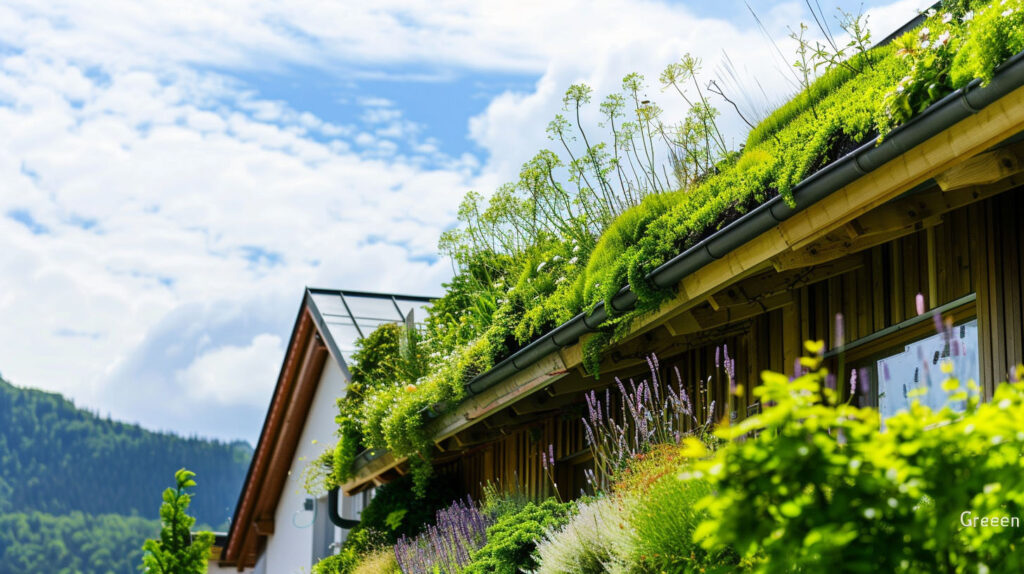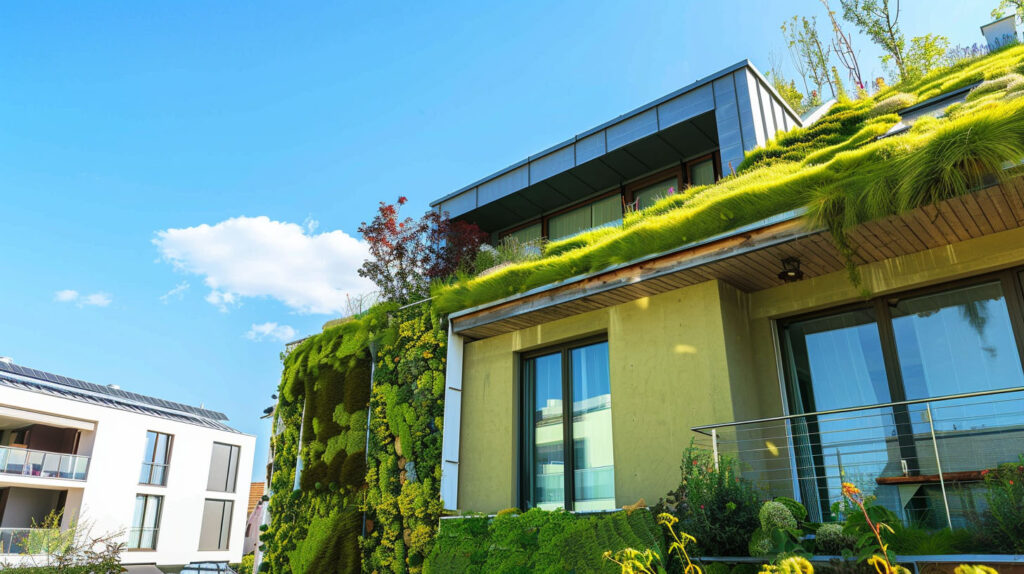What Makes a Roof “Green” or Eco-Friendly?
What makes a roof “green” or eco-friendly? As Orange County, CA homes continue to embrace sustainability, Specialist Roofing & Repair stands at the forefront of eco-conscious roofing innovation. Green roofs go beyond aesthetics; they integrate functionality with environmental benefits in the built environment. From reducing energy consumption to managing stormwater runoff, these roofs redefine roofing solutions. Whether you’re exploring ways to elevate your home’s functionality or contributing to a greener planet, understanding green roofs opens the door to sustainable living.
Understanding Green and Eco-Friendly Roofs
Green roofs, sometimes called living roofs, are far more than just a fashionable architectural trend. They serve multifaceted purposes, addressing energy efficiency, environmental concerns, and stormwater runoff reduction—all within the built environment. By seamlessly integrating vegetation atop rooftops, green roof projects offer sturdy designs packed with eco-friendly benefits, covering vast areas of square feet, measured in square foot dimensions.
There are two primary kinds of green roofs—extensive and intensive green roofs——each tailored for different needs, categorized as types of green roofs. Extensive roofs feature hardy plants and minimal maintenance, while intensive ones resemble lush gardens, providing greater biodiversity but requiring higher structural support.
Defining “Green” Roofing
A sustainable approach to roofing encompasses various innovative designs and materials that prioritize the environment. Green roofing can include extensive and intensive systems, each featuring distinct growing mediums and drainage layers. These roofs not only serve aesthetic purposes but significantly contribute to reining in greenhouse gas emissions, enhancing air quality, and improving energy efficiency. By incorporating features such as vegetation and plant diversity, they foster natural habitats, manage stormwater runoff, and combat the urban heat island effect commonly found in densely populated areas.

Key Differences Between Green and Traditional Roofs
Green roofs offer multiple advantages over traditional roofs, particularly in terms of environmental impact and aesthetic appeal. Unlike conventional roofing systems, which can contribute to the urban heat island effect, eco-friendly roofs, including rooftop gardens, improve energy efficiency through a natural thermal barrier, helping regulate temperature and reduce energy costs. Additionally, the benefits of green roofs extend to supporting biodiversity by providing habitats for various bird species and insects, promoting a healthier urban ecosystem. Their innovative design integrates a waterproofing membrane, growing medium, and drainage layer, enhancing stormwater management and water quality.
Environmental Benefits of Eco-Friendly Roofs
These roofs also manage water runoff effectively, filtering pollutants and enhancing water quality. Energy consumption drops significantly, thanks to the insulation and cooling provided by vegetative layers. As a result, reduced temperature levels and cleaner air elevate the quality of life—not just for your home but for the surrounding cityscape.
Energy Efficiency and Thermal Reduction
Energy efficiency in green roofing systems significantly reduces energy consumption within buildings, addressing the pressing concerns of climate change. These eco-friendly options typically utilize a waterproofing membrane along with a growing medium that absorbs solar radiation, thus minimizing heat transfer. By incorporating green roof technology, structures experience lower energy costs and improved thermal insulation. This strategy not only mitigates the urban heat island effect but also enhances air quality by reducing greenhouse gas emissions, contributing to a more sustainable built environment and supporting the green roof industry.
Stormwater Management and Water Conservation
An effective green roof plays a crucial role in storm water management by absorbing rainwater through its growing medium and drainage layer, significantly reducing runoff. This process also mitigates urban heat islands and lowers the risk of flooding in urban areas. Water conservation is enhanced as the green roof retains moisture, supporting various bird species and maintaining biodiversity. Additionally, these roofs help improve water quality by filtering pollutants, thus promoting overall sustainability within the built environment.

Top Eco-Friendly Roofing Materials for Orange County Homes
Choosing sustainable roofing materials helps set homes in Orange County, CA apart as eco-friendly. Recycled shingles and sustainable tiles provide excellent durability without compromising environmental consciousness.
Metal roofing paired with solar-ready solutions is another strong option. These materials allow direct environmental impact reduction while seamlessly accommodating solar energy needs. With brands like Owens Corning and GAF available locally, Specialist Roofing & Repair provides homeowners confidence in quality and practicality.
Recycled Shingles and Sustainable Tiles
Innovatively crafted from repurposed materials, recycled shingles not only enhance a roof’s aesthetic appeal but also serve as a vital solution in reducing construction waste. Sustainable tiles, often made from natural resources or eco-conscious materials, contribute to energy savings by reflecting solar radiation. Both options play a crucial role in improving air quality while mitigating urban heat islands. These choices support a harmonious balance within the built environment, fostering habitats for various bird species and improving overall quality of life.
Metal Roofing and Solar-Ready Options
Metal roofing’s sleek yet adaptable design makes it an excellent eco-friendly choice. Combining it with solar-ready options, such as photovoltaic panels, transforms rooftops into efficient energy hubs.
Key advantages include:
- Long-lasting roofing solutions, durable against harsh climate conditions in Orange County, CA.
- Support for photovoltaic panel installation, facilitating sustainable energy generation.
- Lower energy needs, reducing dependence on traditional power sources.
By incorporating solar technology, metal roofs meet energy-conscious homeowners’ needs while minimising carbon footprints. Such solutions improve roofing durability and elevate environmental responsibility simultaneously.
Choosing the Right Green Roof for Your Home
Selecting an ideal green roof requires careful consideration. Factors such as design, available green roof technology, and compliance with the International Green Roof Association guidelines can ensure lasting results.
Collaborating with a green roof design team simplifies this decision-making process. Their expertise bridges the gap between climate-specific needs and aesthetic goals, tailoring every project for excellence. Supporting your home while contributing to the greater built environment becomes both practical and inspiring.
Factors to Consider: Climate, Budget, and Aesthetics
Choosing a green roof involves assessing several factors that impact long-term benefits, including different green roof types. Climate plays a significant role—Green roofs reduce heat island effects and cater to varying rain patterns for effective stormwater management, as highlighted in the compendium of strategies.
Key considerations include:
- Budget: Balancing upfront installation costs against energy savings and lower maintenance.
- Aesthetics: Design possibilities allow creative spaces, such as roof gardens meant to enhance biodiversity.
Thinking ahead ensures that your green roof not only transforms your home into an eco-friendly oasis but also suits your lifestyle and urban environment goals.

Working with Certified Contractors in Orange County
Partnering with certified contractors ensures your green roof meets official design standards. Skilled professionals like Owens Corning Platinum Preferred Contractors know how to tailor solutions to local climates.
Key aspects to look for:
- Credentials: Check affiliations with green roof associations and industry certifications.
- Local Experience: Orange County-specific guidelines ensure structures adapt appropriately.
- Full Compliance: Expert teams help meet regulations set by official government organizations to ensure quality and adherence.
At Specialist Roofing & Repair, trusted brands such as Polyglass, ASC, and CertainTeed back our services, providing confidence in every installation.
What’s Next
Sustainable living is increasingly attainable through the adoption of eco-friendly roofing solutions. Opting for green roofs not only aids in mitigating climate change effects but also enhances the quality of life in urban areas. By reducing energy consumption and managing stormwater runoff effectively, these roofs contribute positively to the built environment. Certified green roof technology provides options like living roofs and cool roofs, ensuring a balance between aesthetics and ecological obligation while returning valuable benefits to homeowners and the environment alike.
Frequently Asked Questions
How are green roofs environmentally friendly?
Green roofs enhance air quality by absorbing pollutants like carbon dioxide and particulate matter, thus reducing air pollution. They save energy through natural insulation, leading to reduced energy use, and manage stormwater runoff by filtering pollutants. This combination benefits the built environment and contributes to sustainable urban living.
What makes a roof green?
A green roof, also known as a living roof, integrates a waterproofing membrane, drainage layer, growing medium, and vegetation. These components promote energy conservation, water management, and ecological benefits, making it far superior to traditional roofs.
Read our blog: The Role of Underlayment in a Durable Roof System



